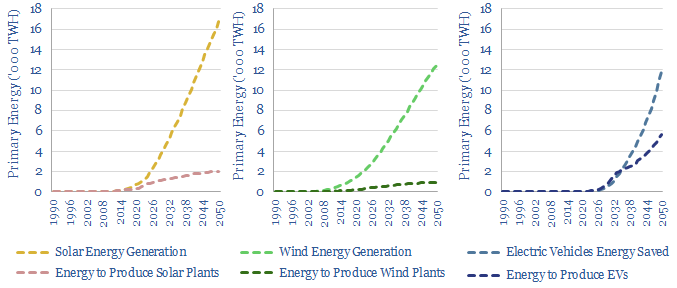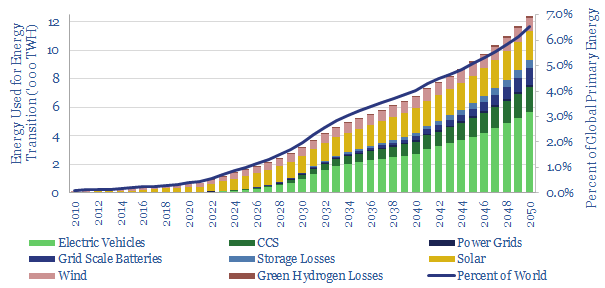Reaching net zero requires building wind, solar, grid infrastructure, energy storage, electric vehicles and capturing CO2. Energy is needed to build all of these things. The total energy costs of energy transition reach 1% of total global primary energy in 2025, 2% in 2030, 4% in 2040 and 6.5% in 2050. In other words, energy transition is materially easier to achieve from a period of energy surplus. You can stress-test numbers in this simple model.
We want to achieve an energy transition, by ramping wind and solar to 25% of the world’s total useful energy by 2050 (note here), building a global fleet of over 2bn efficient electric vehicles, constructing power grid and storage infrastructure, and capturing over 6GTpa of CO2 via various forms of CCS.
This data-file compiles our estimates for each category, quantifying (a) how many units do we want to build? (b) what is the energy cost per unit? (c) by simple multiplication, what are the total energy costs of each category in TWH and as a percent of global primary energy.
However, building all of these things absorbs energy. There are energy intensive materials in a solar plant. There are energy intensive materials in a wind-turbine. And in electric vehicles. Around two-thirds of the energy costs for expanded power grids is embedded in the aluminium of power cabling. Finally, energy storage consumes energy in the form of round-trip efficiency losses, while CCS consumes energy in regenerating amines.
By 2025, around 1,500 TWH of primary energy, or 1.0% of total global primary energy, will be needed specifically to construct these energy transition technologies. The near-term is most heavily weighted to solar, then wind, then electric vehicles.
The numbers grow ever larger as we extrapolate out into the future. The energy transition itself will consume 2% of the world’s primary energy by 2030, 4% by 2040 and 6.5% by 2050.
These are simply enormous numbers. The 2025 number is equivalent to the total primary energy consumption of a country such as Spain or Australia. While the 2050 number is equivalent to two Saudi Arabias worth of oil production.
It is clearly going to be easier to build the important assets and infrastructure needed in the energy transition from a position of energy surplus, and it is going to be more difficult (even, inflationary) if the world is suffering from sustained energy shortages. This is why we think restoring the world’s energy surplus is the most important ESG goal of the 2020s.
The data-file also contains energy balances for each theme in the energy transition. Wind is already in a position of large energy surplus, because wind plants require 50-70% less up-front energy to construct than solar plants (per unit of ultimate generation, e.g., in kWh). The solar chart below is also more finely balanced through the mid-2020s, because solar additions are still accelerating sharply (note here). EV growth is seen accelerating so sharply that building ever more EVs will absorb more energy than they save through the mid-2030s (note here).

The technology that looks most challenged on this roadmap is green hydrogen. Converting useful, rateable electricity into green hydrogen generates no energy savings. There are simply efficiency losses, due to entropy increases, over-voltages at the anode, storage, transport, fuel cells, etc. Our chart above has <0.1% of the world’s useful energy in 2050 coming from green hydrogen. But if the number were 10%, then the total energy requirements of the energy transition would literally double.
The technology that looks least challenged on this roadmap is natural restoration (note here). Nature based solutions may create a 20GTpa CO2 sink with long-term pricing around $50/ton. But planting trees is not an energy intensive activity. There is even an argument that it generates energy, although consuming this energy has varying CO2 credentials.
A key objective for the new energies industry is going to be deploying new technologies that can improve efficiency and lower the energy intensity of energy transition. Hence our own research is also delving into opportunities in energy efficiency.
What are the energy costs of the energy transition? You can stress test numbers in the data-file, flexing total wind and solar installations, total EV deployment, CCS deployment, grid storage, green hydrogen, and the energy intensity factors of each technology.
